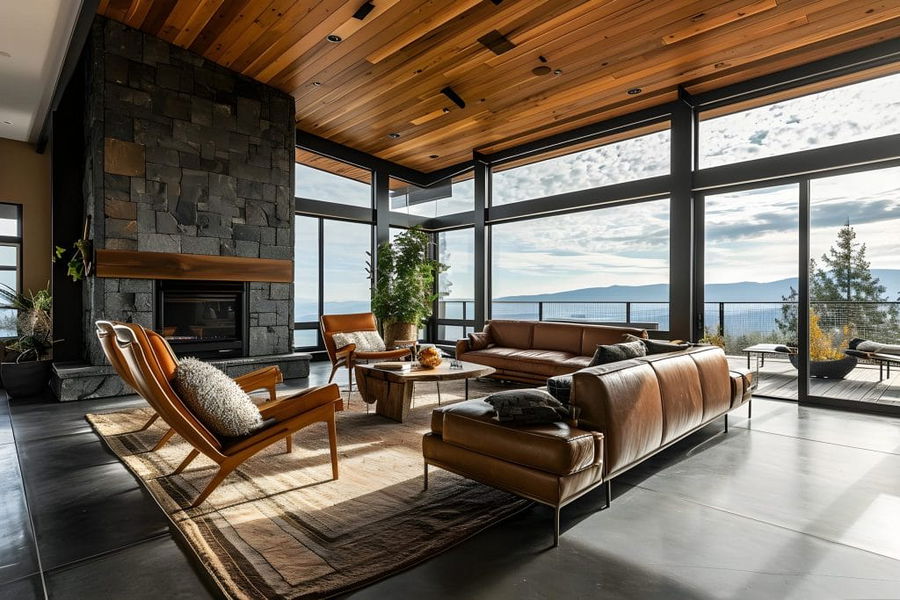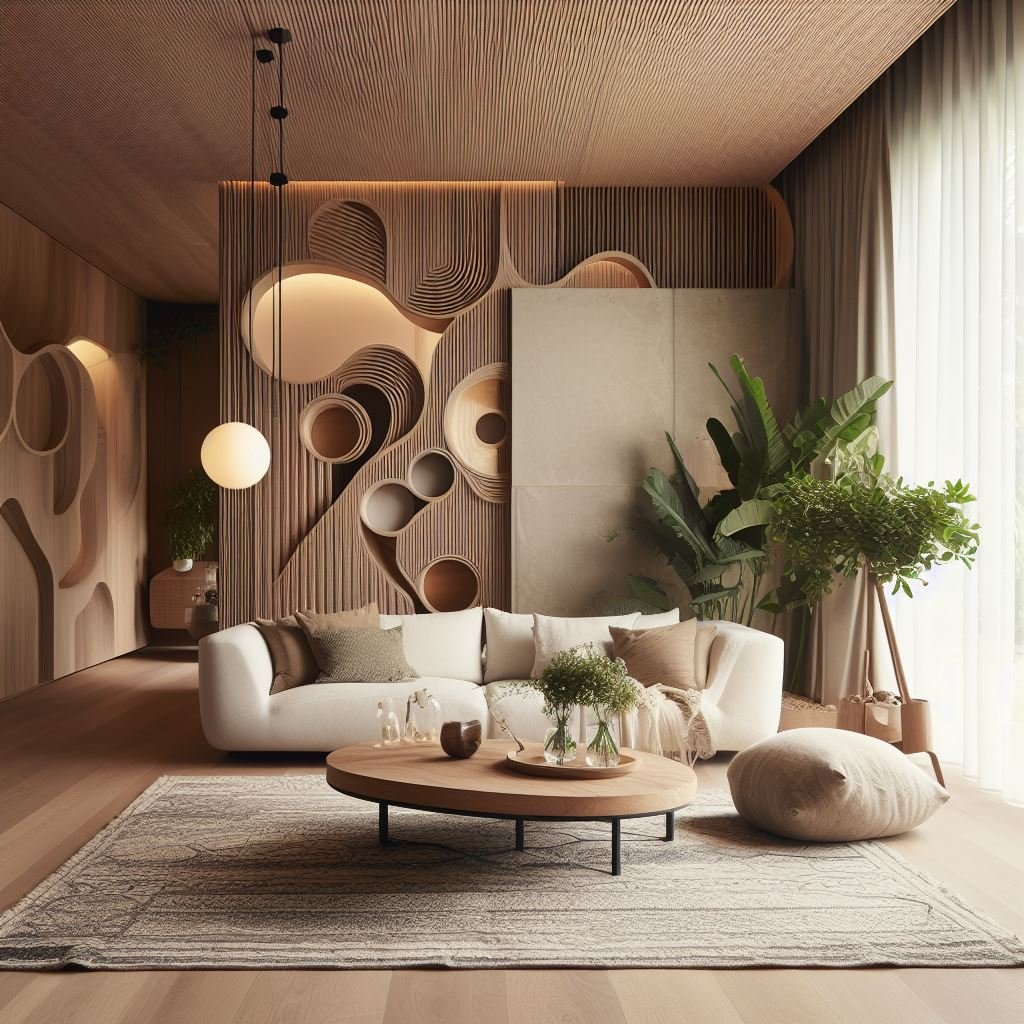Organic modern interior design blends natural elements with contemporary style. It creates a calm, elegant space that feels both fresh and timeless.
In today’s fast-paced world, many seek solace in their homes. Organic modern interior design is the perfect answer. This style combines the clean lines of modern design with the warmth of natural materials. Think of sleek furniture paired with wood, stone, and greenery.
The result is a space that feels both chic and inviting. Whether you’re redesigning your living room or starting from scratch, this approach offers a balanced mix of comfort and sophistication. Dive into this design trend to transform your home into a serene sanctuary.

Credit: www.decorilla.com
Introduction To Organic Modern Design
Organic modern interior design brings a natural and contemporary feel to spaces. It combines clean lines, neutral colors, and natural materials. This design style creates a harmonious and tranquil environment. Let’s explore the concept and key elements that define organic modern design.
Concept And Philosophy
The concept of organic modern design lies in blending modern elements with nature. It emphasizes simplicity and functionality. The philosophy aims to connect indoor spaces with the natural world. This connection promotes a sense of peace and well-being.
Organic modern design avoids clutter and excess. It focuses on essential items that serve a purpose. The design seeks balance and harmony through minimalism. Every piece in the space has a reason to be there.
Key Elements
Natural materials are a cornerstone of organic modern design. Wood, stone, and leather are common choices. These materials bring warmth and texture to the space. They also evoke a sense of connection to nature.
Neutral color palettes dominate the style. Shades of white, beige, and gray create a calm atmosphere. These colors provide a clean backdrop for natural elements to stand out.
Clean lines and simple forms define the furniture and decor. The design avoids ornate and intricate details. This simplicity allows the natural materials and neutral colors to shine.
Indoor plants are essential in organic modern design. They add life and freshness to the space. Plants also enhance the natural feel and improve air quality.
Lighting plays a vital role in organic modern design. Natural light is preferred to artificial light. Large windows and open spaces allow sunlight to flood the rooms. Soft, warm lighting enhances the cozy and inviting ambiance.
Natural Materials And Textures
Organic modern interior design emphasizes natural materials and textures. These elements create a warm, inviting atmosphere. They also bring the outdoors inside. By using natural materials, spaces feel more grounded and authentic.
Sustainable Choices
Sustainability is key in organic modern design. Choose materials that are eco-friendly. Bamboo, cork, and reclaimed wood are great options. These materials are renewable and have a lower environmental impact.
Using sustainable materials also supports responsible sourcing. This ensures that forests and other natural resources are preserved. It’s a win for both your home and the planet.
Incorporating Wood And Stone
Wood and stone are staples in organic modern interiors. They add warmth and texture to any space. Use wood for flooring, furniture, or accent walls. Natural wood grains create visual interest.
Stone adds an earthy element to interiors. Use it for countertops, fireplaces, or decorative elements. Both materials bring a sense of nature indoors.
Combining wood and stone creates a balanced look. The mix of textures adds depth and character to your space. It’s a timeless approach that never goes out of style.
Earthy Color Palettes
Organic Modern Interior Design embraces nature’s beauty. It draws inspiration from the earth. One key element is the use of earthy color palettes. These colors create a calming and inviting space. They include neutral tones and soft accents.
Neutral Tones
Neutral tones are the foundation of earthy palettes. They include shades like beige, taupe, and soft grays. These colors create a serene environment. They allow other elements to shine. Neutral tones also provide a timeless look. They never go out of style.
Accents And Highlights
Accents add depth to neutral tones. Think of rich browns, deep greens, and warm terracottas. These colors mimic natural landscapes. They create a balanced and cohesive design. Highlights in gold or bronze add a touch of elegance. They reflect light and create visual interest.
Furniture And Decor
Furniture and decor play a crucial role in organic modern interior design. This design style blends natural elements with modern aesthetics. The result is a space that feels both warm and sleek. Choosing the right pieces can transform your home into a serene retreat.
Minimalist Pieces
Minimalist furniture is key in organic modern design. These pieces often feature clean lines and simple shapes. They avoid unnecessary details, creating a clutter-free environment. Think of sleek wooden tables or plain linen sofas. These items should serve their purpose without overwhelming the space. Choose high-quality materials that showcase natural beauty.
Functional Aesthetics
Functionality is just as important as aesthetics. Furniture should be both beautiful and practical. For example, a stylish coffee table can also offer storage. Or a chic bookshelf that doubles as a room divider. Each piece should enhance the room’s functionality. This approach ensures that your space is not only attractive but also useful.
Decor items should also serve a purpose. Consider multi-functional decor like storage baskets or decorative trays. These items can keep your space tidy while adding visual interest. Remember, less is more. Focus on pieces that bring both form and function to your space.
Credit: https://www.youtube.com
Indoor Plants And Greenery
Indoor plants and greenery play a key role in organic modern interior design. They bring a touch of nature inside, creating a serene and refreshing environment. Plants also add texture and color to a minimalist space, making it feel alive and vibrant. Let’s explore the benefits of indoor plants and how to choose the right ones for your home.
Benefits Of Indoor Plants
Indoor plants improve air quality. They absorb carbon dioxide and release oxygen. This helps create a healthier living space.
Plants also reduce stress. Their presence has a calming effect. It can make you feel more relaxed and peaceful.
Another benefit is that indoor plants enhance the aesthetics. They add natural beauty and can be a focal point. This makes your home more inviting.
Plants can also increase humidity. This is beneficial for your skin and respiratory system. It can help keep you comfortable.
Choosing The Right Plants
Consider the light in your home. Some plants need bright light. Others thrive in low light.
Think about maintenance. Choose plants that fit your lifestyle. Some plants need frequent care. Others are low-maintenance.
Consider the space available. Large plants need more room. Small plants can fit anywhere.
Research the plant’s needs. Ensure you can meet them. This helps the plant thrive.
Popular choices include succulents, ferns, and snake plants. Each has unique benefits. Choose what suits your home best.
Lighting And Ambiance
Lighting and ambiance play a crucial role in modern interior design. They set the mood and enhance the natural elements. The right lighting can transform a space into a serene retreat. It can highlight the beauty of natural materials and create a warm, inviting atmosphere.
Natural Light
Natural light is essential in organic modern design. It makes spaces feel open and airy. Large windows and skylights are great for letting in natural light. They connect the indoors with the outdoors. Use sheer curtains to diffuse the light. This creates a soft glow and reduces harsh shadows.
Soft And Warm Lighting
Soft and warm lighting is perfect for organic modern interiors. It creates a cozy and inviting ambiance. Use warm white bulbs for a natural feel. Lamps with fabric shades can soften the light. Dimmers are useful for adjusting the light level. They allow you to change the mood of the room easily. Consider using candles for a gentle, flickering light. They add warmth and a touch of nature.
Sustainable Practices
Organic Modern Interior Design emphasizes creating spaces that are both stylish and sustainable. Adopting sustainable practices within this design style helps protect our environment. It also ensures that your home is healthy and eco-friendly. Let’s explore some key sustainable practices in Organic Modern Interior Design.
Eco-friendly Products
Choosing eco-friendly products is a fundamental aspect of Organic Modern Interior Design. These products are made from natural, non-toxic materials. Look for furniture made from reclaimed wood. It reduces the demand for new resources. Natural fibers like cotton, wool, and linen are excellent choices for textiles. They are biodegradable and environmentally friendly.
Low-VOC paints are another great option. They emit fewer harmful chemicals into the air. This makes your indoor air quality much better. Bamboo and cork are also sustainable materials. They grow quickly and are highly renewable. Using these materials in your design creates a healthy living space.
Energy Efficiency
Energy efficiency plays a crucial role in sustainable interior design. Using energy-efficient appliances reduces your carbon footprint. LED lights are a smart choice. They use less energy and last longer than traditional bulbs. This saves you money and reduces waste.
Consider installing a programmable thermostat. It helps maintain an optimal temperature in your home. This reduces energy consumption. Additionally, using double-glazed windows can significantly improve insulation. This keeps your home warm in winter and cool in summer. Proper insulation is key to energy efficiency.
Solar panels are another excellent addition. They provide renewable energy and reduce reliance on fossil fuels. Even small changes, like using energy-efficient light bulbs, can make a big difference. Embrace these practices to create a sustainable, energy-efficient home.

Credit: blog.buyerselect.com
Creating Cozy Spaces
Creating cozy spaces in your home is essential for achieving an inviting atmosphere. In organic modern interior design, warmth and comfort are key elements. By incorporating natural materials, soft textures, and personal touches, you can transform any room into a relaxing haven.
Layering Textiles
Layering textiles is a great way to add depth and warmth. Use a mix of natural fabrics like cotton, wool, and linen. These materials not only feel good but also look great.
For example, you can layer a soft wool rug over a jute carpet. Add a cotton throw blanket on your linen sofa. This mix of textures creates a rich, cozy feel.
| Material | Use |
|---|---|
| Wool | Rugs, blankets |
| Cotton | Pillows, throws |
| Linen | Sofa covers, curtains |
Personal Touches
Adding personal touches makes a space feel uniquely yours. Display items that have meaning to you. This could be family photos, travel souvenirs, or handmade crafts.
Consider creating a gallery wall with your favorite photos. Use simple wooden frames for a natural look. Another idea is to place a few cherished items on open shelves or a coffee table.
- Family photos
- Travel souvenirs
- Handmade crafts
These personal elements not only add warmth but also tell your story.
Balancing Modern And Organic
Finding the right balance between modern and organic elements in interior design can create a space that feels both fresh and welcoming. By combining sleek, contemporary lines with natural materials, you can achieve a harmonious living environment that is both stylish and comfortable.
Harmonizing Elements
To harmonize elements in your design, consider using a blend of modern and organic materials. For instance, pair a sleek metal table with wooden chairs. This combination brings together the best of both worlds.
Another way to harmonize elements is through color. Use neutral colors like beige, gray, and white. Then, add pops of color with green plants or earth-toned accessories. This creates a balanced look that is visually appealing.
Textures also play a crucial role. Incorporate a mix of smooth surfaces and rough textures. A concrete floor can be softened with a wool rug. This contrast adds depth and interest to the space.
Avoiding Clutter
Clutter can disrupt the balance of modern and organic design. To keep your space clutter-free, follow these tips:
- Choose multi-functional furniture like a coffee table with storage.
- Use baskets and bins to organize items.
- Keep surfaces clean and clear.
Avoid over-decorating. Select a few key pieces that add to the overall design. This keeps the space uncluttered and elegant.
Utilize vertical space. Install shelves to store and display items. This helps maintain a tidy and organized room.

Credit: www.lorddecor.com
Frequently Asked Questions
What Is Organic Modern Interior Design?
Organic modern interior design blends natural materials with minimalist aesthetics. It emphasizes sustainability, comfort, and simplicity.
How Do You Achieve An Organic Modern Look?
To achieve an organic modern look, use natural materials, neutral colors, and simple, clean lines in your decor.
What Materials Are Used In Organic Modern Design?
Common materials include wood, stone, linen, and wool. These elements add warmth and texture to the space.
Is Organic Modern Design Sustainable?
Yes, organic modern design focuses on sustainability. It uses eco-friendly materials and promotes a minimalist, less-is-more approach.
Conclusion
Embrace organic modern design for a calm, stylish home. Blend natural elements with sleek lines. Choose sustainable materials. Create spaces that breathe. Enjoy a clutter-free environment. Focus on comfort and simplicity. Your home will feel inviting and serene. Experiment with textures and colors.
Celebrate nature indoors. Achieve a timeless, elegant look. Organic modern design suits any lifestyle. Start transforming your space today. Feel the difference.



